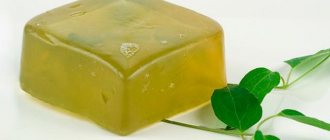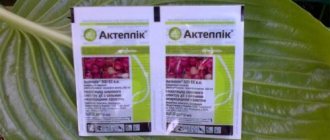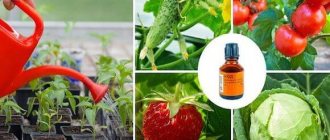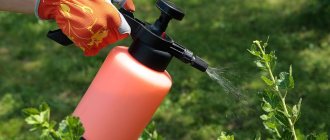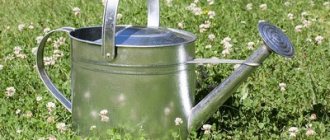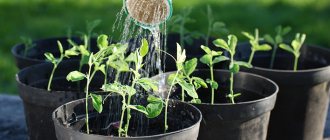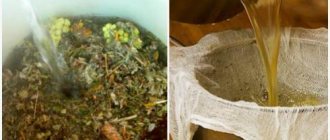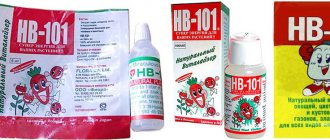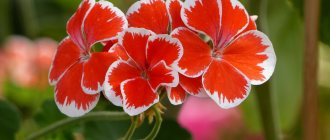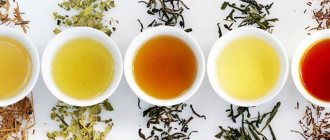An insecticide with contact action. Active ingredient: potassium salts of fatty acids. Produced by several manufacturers: Green Belt, Fasco, Sadovnik, etc., in the form of a solution (0.25 l, 0.5 l). Ingredients: water, potassium salts of fatty acids, natural fats and vegetable oils. It is considered an environmentally friendly drug.
Used to protect garden crops and indoor flowers from pests: thrips, scale insects, aphids, bedbugs, pennies. Potassium salts are also effective against some types of mites, but are not effective or have little effect against whiteflies and scale insects!
Application
Green soap is used in its pure form, diluted with water, or as an adhesive in solutions where an alkaline reaction is acceptable (the pH of the solution is from 7 to 8), or in a mixture with other agents (infusions of herbs, tobacco, etc.).
How to dilute green soap against pests:
- against aphids and mites 200-400 g of green soap per 10 l
- against scale insects 200-300 g of green soap per 10 l
- against aphids 200-400 g of green soap per 10 l
To combat bedbugs, green soap is used as part of a complex solution: 4 parts potassium soap, 1 part turpentine, 2 parts kerosene and 12 parts water.
For indoor flowers, the recipe is simple: dissolve 1 tablespoon of green soap in 1 liter of warm water. If a measuring cup is included, use it as directed.
Features of the drug
The effect of soap on insects and arthropods (ticks) is to envelop the body with a film and block the respiratory tract.
Green soap can be mixed with other insecticides, in particular with decis, karbofos, intavir, at the rate of 40-100 g per 10 liters of water; soap, in addition to its main properties (toxicity to pests), gives the pesticide solution better stickiness, i.e. the solution forms a more stable film over the surface of the sheet.
For the same reason, green soap is often used in combination with fungicides against a number of plant diseases, for example, powdery mildew, rust, and fungal spotting. Usually the main component is some kind of copper-containing preparation, for example, copper sulfate. To prepare 1 liter of solution, pour exactly 800 g of warm water into a 1-liter jar, add 30 g of green soap and mix. In another jar, 2 g of copper sulfate is dissolved in 200 g of warm water. Then slowly (in a thin stream) with continuous stirring with a wooden stick, pour the vitriol solution into the soap solution. This solution is sprayed on the plants leaf by leaf against fungal infections.
Gardeners often use a solution of green soap against powdery mildew and other diseases, in combination with soda ash. In this case, take 50-100 g of soap and 50 g of soda per 10 liters of water.
Another effective recipe for ticks: 20 g of ground dried garlic (40-50 g of fresh garlic), 200 g of green soap, diluted with water to 10 liters of water. If the garlic is fresh, you need to crush it in a mortar, if dry, steam it in a small amount of boiling water.
No more than 3 applications per season are allowed with green soap. Process for the last time no later than 5 days before harvest.
Toxicity
Green soap has a hazard class of 4 (low hazardous substance). Not phytotoxic. Practically non-toxic for birds, earthworms, soil microorganisms and bees (the border protection summer zone for bees is at least 3 - 4 km, the flight limit for bees is 48 - 72 hours).
Fruit or berry trees and shrubs can be processed at least five days before harvest. If green soap is not used in its pure form, but with the addition of other pesticides or turpentine, then treatments are carried out before flowering, or after harvesting, no later than 30 days before harvesting.
Security measures. Handle using gloves. While working, you must not smoke, drink, or eat. Dilute the working fluid solution exclusively in glass or porcelain containers. Do not use dishes that have come into contact with alkali for household purposes or cooking. Store the drug in a cool, dry room at a temperature from -10C to +35C, separate from food and medicine, out of the reach of children and pets! Storage of the working solution is not allowed. The shelf life of green soap is 1-2 years (see on the package).
First aid for poisoning: if the drug gets on the skin, rinse with plenty of water, to neutralize the alkali, apply a gauze bandage soaked in a 5% acetic acid solution to the affected area after rinsing (for 10 minutes). After removing the bandage, rinse the skin with water. In case of contact with eyes, rinse thoroughly with running water for 15-20 minutes. Then rinse the eyes with a 2% solution of boric acid and drip albucid. Do not hesitate to consult an ophthalmologist. If ingested, drink 3-4 glasses of water, induce vomiting, take several tablets of activated charcoal, and seek immediate medical attention.
All experienced gardeners and gardeners are familiar with fungicidal soap. This product has proven itself to be excellent. It stands out from the rest due to its compatibility with other drugs, safety for humans and high efficiency.
Pest Control
Tar soap, due to its specific aroma, repels pests well. To use the soap, you need to grate it using a regular grater. The shavings are used both in indoor floriculture and in the garden. If midges appear, then it should be poured in small quantities onto the soil. To treat large areas, a solution based on tar soap can be used. Need to:
- grind two pieces of soap on a coarse grater;
- pour two liters of warm liquid;
- stir until a homogeneous mixture is obtained.
The resulting composition can be bottled for storage. If the need arises, you need to dilute a liter of liquid soap with 5 liters of water, resulting in a concentrate being created. A liter of liquid is poured into a 10-liter watering can and diluted with 9 liters. water. The method allows you to eliminate:
- flies,
- codling moth,
- aphids,
- weevil,
- Colorado potato beetle and other pests.
It is not recommended to water crops at the flowering stage with a tar-based mixture, since beneficial insects may stop pollinating them.
How it works
After spraying, an environment is formed that prevents the development and reproduction of parasites. Adults that are on the treated plant die, as they lose the ability to eat and breathe.
This happens because the drug used contains components that turn into a film. It covers all surfaces, tissues, including the insects themselves. Layed eggs that have been exposed to the product stop developing and gradually die.
Important: insecticidal soap is used not only to fight insects, but also to prevent their appearance.
First aid for plants
Experienced gardeners understand why green soap is needed in the garden, so they actively use it as a protective agent. The secret of the action of the natural substance is the formation of a film on the surface of the leaves. Thanks to this, the parasites become trapped. Those that remain on the surface stop feeding, reproducing and moving. They are also covered in a sticky substance that prevents them from laying eggs or even breathing.
Let's look at detailed instructions for using green soap. It will help protect gardens from various ailments and pests.
The product is effectively used to prevent the occurrence of such diseases:
- late blight;
- scab or rust;
- cytosporosis;
- powdery mildew;
- fungal spot.
Often green soap is mixed with active ingredients:
- ash;
- tobacco;
- garlic;
- herbal decoctions.
To do this, take approximately 100 g of the drug. Then it is diluted in 10 liters of tincture of various herbs. The resulting product is generously sprayed onto garden crops. As a result, a protective environment is formed against all kinds of diseases. That's what green soap is for plants when used correctly.
The diluted drug is absolutely harmless to soil microorganisms, earthworms, birds, water inhabitants and bees.
What is green soap used for?
It is rarely used in its pure form; it is often diluted with water. Plants of any type are sprayed to get rid of insects and prevent their appearance. The substance also helps to cope with a number of diseases that are inherent in various domesticated crops.
From diseases
In the treatment and prevention of many plant ailments, the drug is used as part of a highly effective mixture based on copper sulfate. This solution is considered the most effective remedy against fungi.
Dilute 250 g of soap into 10 liters of water at room temperature. 25 g of copper sulfate are dissolved in 2 liters of hot liquid. When both preparations are ready, slowly pour the second one into the soap solution, stirring thoroughly during the process.
The above-ground part should be sprayed three times a month. When it comes to outdoor plants, you need to choose a day with little sun and no wind. There should be no rain in the next week.
Processing indoor flowers
For small representatives of home flora, little solution is needed. 1 tbsp is enough. active substance per 1 liter of water at room temperature. It is better if the liquid sits for at least a day before cooking.
Some instructions for using insecticide for the most popular indoor plants, as an example.
Green soap for orchids, how to use:
- The maximum dose is 100 ml per 10 liters of water.
- If the flower is severely damaged, the procedure is repeated.
- No more than 3 treatments with an interval of 1 week.
- Cut flowers if present. If the solution gets on them, the buds will quickly wither and fall off.
- After spraying, place the pot with the sick “tenant” in quarantine and cover it with film to enhance effectiveness.
Green soap for violets, method of use:
- The proportions of the solution are 200 ml per 10 liters of water.
- Spray 1 to 3 times weekly.
- Prevention after treatment - 100 ml per 10 liters monthly in the summer, and then - once a season.
- To combat severe disease, use in combination with copper sulfate - 200 ml of soap and 25 g of copper sulfate per 10 liters.
Tip: for the convenience of measuring the amount of the drug, you should know that 1 tbsp. - this is 50 ml of Green soap.
Pest use
Judging by numerous user reviews, this product has proven itself in the fight against most insects when spraying ornamental, flowering, climbing, fruit and berry plants.
On average, the emulsion is prepared in a proportion of 50 ml per 1 liter of hot water. But more accurate calculations of consistency are made by referring to the size of the flora representative and the degree of parasite damage.
Important: before spraying, you need to cover the earthen ball with film, otherwise the plant may die if the substance gets into the soil.
When fighting sucking plant parasites, a more effective combination is prepared: 1 kg of tobacco waste is left in a bucket of water for 24 hours, filtered, and 10 liters of water and 25 g of soap are added. Wood ash is often used as an additional component.
Can it be used in cosmetology?
There is an analogue of this drug of the same name, but with different properties. Green soap, depending on the manufacturer, has a viscous or solid structure. The composition is closer to a regular hygiene product, but contains a whole complex of plant components, for example: pine nut extract, pine needle extract, etc. Used universally to cleanse the body, hair and scalp.
Green soap can be included in detergents in varying concentrations, from 20 to 70%. Due to their environmental friendliness and naturalness, these products are suitable for allergy sufferers.
This is interesting: in the northern regions, such soap is the basis of mixtures used to treat frostbite of the skin.
Scope of use of the product
Green soap is a product purchased to solve problems that arise during plant growing. It is generally accepted that the insecticide is most effective in the early stages of the disease, and also as a prophylactic agent.
Pest control
The environmentally friendly insecticide is not an overtly toxic substance, but has proven itself favorably in the fight against timely detected foci of insect attack. Despite the selectivity in objects exposed to the toxic effects of green soap, the list of pests affected by it is impressive:
- aphids (fruit, vegetable, flower, manifested both in open ground and indoors);
- spider mite;
- sawflies;
- bibs;
- psyllids;
- pennies, etc.
At the first harmful manifestations, the surface of the plant should be irrigated with a solution of green soap. It is more convenient to use a finely dispersed sprayer, which allows you to thoroughly treat both the external and internal parts of shoots, leaves and stems.
The use of green soap is possible during the flowering period without loss of volume of ovaries by fruit and berry crops. “Bathing” branches and shoots of plants, which are immersed in a container with a solution for a few seconds, can be successfully applied.
Seasonal attack of fruit aphids
Disease Control
In the form of an independent solution, green soap has a preventive rather than a therapeutic effect in cases of fungal infections of plants. The protective film formed on the surface of foliage and shoots helps strengthen the immunity of a healthy crop under conditions of risk of proximity to infected people.
Diseases that can be successfully treated with alkaline soap:
- powdery mildew;
- gray rot;
- rust;
- late blight, etc.
In case of pronounced manifestations of plant diseases, green soap is used as an additional component of a solution based on fungicides, pesticides, etc. The viscous oil film of the ecological preparation envelops the molecules of the chemical substance and retains them on the surface, protecting them from being washed off by precipitation and prolonging the period of action.
Powdery mildew on cucumbers
How to prepare a solution: proportions
Presence of sediment is normal. The substance must be shaken before use. To make the mixture more effective, you should use soft water.
Green soap for plants is mixed with other insecticides: Decis, Karbofos, Intavir. At the rate of 1:2 per 10 liters of water. This is done in order to enhance the effectiveness of the treatment in destroying fungal spotting, rust, powdery mildew and other persistent and dangerous diseases.
Recommendations for determining the required consistency:
- Together with soda ash, it helps destroy powdery mildew and most other diseases of similar etiology. For 10 liters of water, dilute 50-100 g of soap (depending on the degree of damage) and 50 g of soda.
- Green soap for spider mites and aphids - 200-400 ml of active ingredient per 1 bucket of water. Spraying is carried out during the active growing season or at the end of November.
- To spray a plant affected by scale insects, you need a solution of 300 g of soap per 1 bucket of water.
- As the main weapon in the fight against bedbugs, prepare the substance in the following proportions: 4:1:2:12 - Green soap, turpentine, kerosene, water at room temperature.
The standard therapeutic concentration is 250 g per 10 l, and the preventive concentration is 100 g per the same amount of liquid.
Important: no more than 3 soap treatments per season are allowed. Last time no later than 5 days before harvest.
When making a base or complex mixture, the main thing is that all components dissolve in water.
How to use green potassium soap for grapes
Viticulture is a fun, but difficult business, especially difficult for beginners. A fragile plant is exposed to adverse environmental factors and is attacked by harmful insects and fungi. An environmentally friendly product used by summer residents for many years will help save the grapevine from this scourge.
Most often, grapes are affected by powdery mildew and other fungal infections, which threatens yield loss.
Since grape processing is carried out in the fresh air, it is recommended to plan this procedure on a warm and dry day. Prepare a solution by mixing the product with warm water in an amount of 10 liters. So, to combat fungal diseases, it is recommended to use 300 ml of green soap , and 250 ml of the drug will help against pests.
Most often, grapes are affected by powdery mildew and other fungal infections, which threatens yield loss
During the summer season, it is allowed to use potassium soap 2 to 3 times, but no later than 10 days before harvest.
Grapes affected by harmful insects should be sprayed starting from the bottom of the plant, directing the jet to concentrate the parasites, and uniform treatment is effective against the fungus. A repeat procedure to consolidate the result obtained is carried out no earlier than 12 days later.
Green soap helps keep the grapevine safe and sound, and preventive spraying at the beginning of each year minimizes the risk of the plant being affected by diseases.
Grapes affected by harmful insects should be sprayed starting from the bottom of the plant, directing the jet to concentrate the parasites, and uniform treatment is effective against the fungus.
Green soap: instructions for use
The use of such an effective remedy must also be correct, otherwise you can do a lot of harm. Choosing consistency is just the beginning. You should calculate the time frame between pollinations and choose a good period for work. Otherwise, the result will not be as expected.
Spraying is carried out during cloudy periods or in the evening when the sun is moving towards sunset.
If you need to use Green soap for pests, the instructions are as follows:
- At the beginning of spring, before the formation of buds, treatment is carried out in order to get rid of the offspring of parasites that were left behind from last year and survived the winter. A similar procedure takes place in late autumn.
- As a preventive measure against pests, the substance is applied in the form of a 2-4% solution. The drug is especially effective against aphids and spider mites.
To treat adult trees, prepare a 1:2 solution, and at the height of the season, when there is a lot of greenery on branches and bushes, the soap is diluted up to 12 times.
Recommendations for use according to plant type: table
| Fruit trees | Treated in early spring for preventive purposes. If necessary, the procedure is repeated in the summer 2-3 times maximum. |
| Berry bushes | Sprayed in the spring, before flowering, and in the fall, after the entire harvest has been harvested. |
| Vegetables | Cabbage, cucumbers and tomatoes are irrigated during the seedling growing period. Other crops - as needed, even during active growing season. |
| Floral and decorative garden plantings | Treat at the first sign of infection. If the procedure occurs during budding or flowering, you should spray carefully so that the substance does not get on the ovaries. |
| Houseplants | Treatment can be carried out throughout the year. After applying the solution, the flower is quarantined, covered with a large bag or film for 3 hours. Then dry well and rinse off any remaining product. |
Thrips
The presence of thrips on an orchid will be indicated by a change in the color of the leaves, the appearance of small dots and streaks on the underside of the leaf blades, as well as a silvery film on any part of the plant. The reason for this external change is small, almost transparent insects that feed on orchid sap. Damage from them is very similar in appearance to damage from spider mites, but has a stronger and more pronounced effect. These insects are dangerous because they hide in the substrate and cannot always be detected in time. However, thrips damage not only the roots, but also the leaves and flowers of the orchid. And these pests can grow on absolutely any orchids.
Reason for appearance
Most often it is a neighboring plant damaged by thrips. The risk of infection is especially likely when air humidity is low.
How to get rid of thrips
It is extremely difficult to get rid of thrips: these pests have wings and therefore can easily move from the orchid to other plants. That is, such insects pose a danger to all inhabitants of the home flower garden - therefore, at the first sign of damage to the orchid by thrips, you need to take action immediately.
First of all, you need to wash the orchid well under a warm shower. As with spider mites, this will not completely rid the plant of pests, but it will help reduce their population.
Then all damaged areas of leaves must be cut back to healthy tissue.
At the final stage, the plant should be sprayed with BioKill or Fitoverm according to the instructions, repeating the procedure twice more every 10 days.
Thrips on an orchid leaf
Folk remedies
After moving the orchid into quarantine, it can be sprayed with a daily infusion of onion or garlic, crushed into a pulp - 1 tsp. for 1 glass of water.
Olive oil mixed with water also helps against thrips. They spray the orchid with it. To prepare the product you need to mix 2 tbsp. oils with 1 liter of water.
Prevention
Thrips most readily settle on the inside of leaves. Therefore, the best prevention would be regular inspection of the orchid’s leaf blades. It is especially important to do this in the warm season, as well as during the heating season, when the air humidity in houses and apartments decreases greatly, and the temperature increases.
Security measures
Processing is carried out with gloves. As with spraying with other chemicals, do not pause for lunch or smoke during the process.
- Use only for spraying plants, do not add to preparations for root treatment.
- Do not wash your hands with the substance or wash things.
- After the procedure, wash your hands with normal hygiene products and rinse the instruments well.
The solution is prepared in a glass or porcelain container. Do not use utensils that come into contact with alkali, food, or are used for household purposes.
Wide range of applications
An effective remedy is obtained by combining 50 g of soap and 1 liter of boiling water. When the emulsion has cooled, add clean water to it with constant stirring.
The solution is used to treat:
- fruit trees;
- berry bushes (currants, raspberries, blackberries);
- garden crops (cucumbers, tomatoes, cabbage, potatoes).
The procedure is carried out on cloudy days or after sunset.
The composition of green soap allows it to be used in the fight against harmful insects:
- aphids;
- various caterpillars;
- spider mite;
- soil fly;
- miniature false shield.
Some gardeners combine fungicidal soap with ash and tobacco waste. Add 25 g of the drug plus the active substance to 10 liters of water. Leave the solution for 24 hours. Used for spraying garden crops against annoying insect pests. To do this, it is important to follow the instructions for green soap against pests of a specific type.
A substance made from the following components will help get rid of bedbugs:
- potassium soap (4 hours);
- turpentine (1 tsp);
- kerosene (2 hours);
- water (12 parts).
To combat aphids, soap (approximately 400 g) is diluted in 10 liters of water. It is easy to destroy scale insects with a liquid consisting of 300 g of the substance diluted in 1 bucket of water.
You can use green soap against spider mites if you combine it with stronger insecticides:
- "Decis";
- "Karbofos";
- "Intavir".
We recommend reading: On January 31, 1961, a chimpanzee was sent into space for the first time
Add 40 to 100 g of substance per 10 liters of water. The toxic agent will not only quickly neutralize the pest, but will also increase its stickiness on the surface of the leaf plate. In addition, it is important to know how to use green soap correctly so as not to harm the plants. It is strictly forbidden to add immunomodulators and all kinds of root fertilizers to the preparation. Otherwise, the culture may weaken and even become sick.
As is known, the interaction of acid and alkali produces dangerous compounds. They can have a detrimental effect on the growth and development of a culture. Green soap is slightly alkaline.
Storage conditions
Store in a cool, dry place, at a temperature of -10...+35°C. At a great distance from food, seeds, seedlings, etc.
Important: the shelf life of Green Soap is up to 2 years (see on the package). The working solution cannot be stored for long periods of time, especially when mixed with other substances, as they may react.
It is better not to change the original container unless absolutely necessary. If this is unavoidable and the container is damaged, the replacement must be tightly closed.
Green soap for pests: reviews from gardeners and gardeners
This environmentally friendly product is widely used by domestic gardeners and flower growers to protect fruit trees, garden crops and indoor plants from pests. The effectiveness of such a remedy in the prevention and treatment of damage by thrips, scale insects, aphids, bugs, and pennies has long been proven in practice. Can be used against spider mites. Low efficiency is observed when protecting plants from whiteflies and mealybugs.
Before diluting the product, the container with the composition must be shaken quite vigorously. Each drug comes with intuitive instructions, in accordance with which dilution is carried out.
The soap solution has proven itself well in mixtures with herbal infusions, as well as tobacco and other plant fungicides. In this case, it is recommended to use the following concentrations:
- against plant aphids and spider mites, use a solution based on 200-400 g of green soap and a bucket of water at room temperature;
- against scale insects, use a solution based on 200-300 g of green soap and a bucket of water at room temperature;
- against bedbugs, a solution is used based on four parts of potassium soap, one part of turpentine, two parts of kerosene and twelve parts of water at room temperature.
The standard and quite effective proportion is a quarter of a kilogram per bucket of warm water. Treatment is carried out no more than three times at weekly intervals. A smaller proportion of soap is used in preventive measures. A larger amount of insecticidal substance is used for treatment.
Green soap is used in the prevention and treatment of many diseases in highly effective mixtures based on copper sulfate. This combination can significantly enhance the antifungal effect of the solution.
For this purpose, you need to dilute a quarter kilogram of soap in a bucket of water at room temperature, and 25 g of a copper-containing product is diluted in a couple of liters of relatively hot water. At the final stage of preparation, a copper-containing product is slowly poured into the soap solution with thorough stirring.
Soap solutions are quite successfully used in indoor floriculture for the prevention and treatment of beautiful flowering and decorative foliage plants. For this purpose, it is recommended to use a solution based on a liter of water at room temperature with the addition of a tablespoon of fungicidal agent to spray the above-ground parts of indoor crops.
As numerous reviews show, the product has proven itself well in growing orchids and is widely used as a preventative solution in flower beds with ornamental perennials and annual crops. This solution can also be used to treat berries, including raspberries, currants, gooseberries, chokeberries and grapevines.
For this purpose, an emulsion is prepared based on 40-50 g of soap and a liter of boiling water. Clean water is added to the mixture, which has cooled to room temperature, with constant stirring, which makes it possible to obtain a solution for spraying fruit trees, berry bushes and garden crops in the evening or in cloudy but not rainy weather.
To protect against sucking plant parasites, tobacco-soap solutions based on a kilogram of tobacco waste and a bucket of hot water are used. The mixture is infused for a day and then filtered. To a couple of liters of solution you need to add 10 liters of warm water and 20-25 g of soap. An infusion of wood ash can be used as an additional active component.
Green soap (instructions for which are included in the package) is dissolved in warm and not hot or cold water. To bait any type of insect, the following proportions are used:
- from aphids and plant mites: 300 ml of soap per 10 liters of water;
- from scale insects: 200 ml of green substance for every 10 liters of water;
- A mixture of products is effective against bedbugs: 4 parts soap, part turpentine, 2 parts kerosene dissolved in 12 parts warm water.
We invite you to read: The cat scratches its face until it bleeds
It is unacceptable to thoughtlessly add soap solutions to other drugs. For example, you should not supplement foliar feeding with them, the purpose of which is the unhindered penetration of nutrition into plant cells. It is also not recommended to mix soapy liquids with immunomodulators (epin, zircon, silk, etc.).
Most compatibility restrictions are related to chemical acidity indicators. Alkalies and acids usually neutralize each other when they interact, which can result in the formation of useless or even dangerous products. Green soap has a slightly alkaline reaction. You should definitely not mix it with lime (insoluble calcium derivatives appear).
Further it will be more difficult, because the recommendations of agrochemist specialists can be very contradictory.
1. On the one hand, substances containing copper are recommended to be used separately. On the other hand, the instructions for green soap (and the practical experience of gardeners) allow its combination with copper sulfate, HOM, Oxychom.
2. Oily elements of soapy liquid can burn plants in combination with sulfur-based substances (Tiovit Jet, etc.). Although there are recommendations for preparing such mixtures, caution must be exercised.
3. Almost all pesticides have a slightly acidic reaction. But the instructions allow combining green soap with fungicides such as Topaz and Skor, as well as with many insecticides, such as: Inta-Vir, Decis, Kinmiks, Arrivo (pyrethroids); Karbofos (organophosphorus); actara, confidor (neonicotinoids); fitoverm (a biological product from the avermectin group); Regent; Iskra et al.
Any mixtures cannot be used to treat plants if there is a violent chemical reaction or precipitation occurs (flakes, etc.).
Soap solutions go well with folk remedies (kerosene, tobacco, mustard, wood ash, whey and milk, herbal infusions, etc.).
The concentrate is shaken, eliminating possible natural sediment. Then the substance is diluted with clean water; It is advisable to take an enamel, plastic or glass container for this purpose. The solution is used to irrigate the foliage (covering the underside) and plant shoots. The most effective is fine spraying from a high-quality pump sprayer;
Environmentally friendly preparations, not being strong poisons, are especially effective at the initial stage of plant colonization by pests; Large colonies and massive invasions are not easy to eliminate. green soap has proven itself well, primarily as a means of suppressing all types of aphids on a wide variety of crops (vegetables, berries, fruits, ornamental foliage, flowers, including greenhouses, indoors). The drug is also used against mites (including spider mites), scale insects, thrips, sawflies, honey psyllids, and pennies.
Of course, the use of any drug requires caution: precise dosages, compliance with protective and hygienic requirements (keep children away, work with gloves, protect eyes, etc.). It is advisable (unless otherwise stated) to use freshly prepared mixtures. Residues should not be poured under the roots of plants.
Unlike many other insecticides, our soapy liquid solution does not pose a danger to bees and other pollinating insects, but it is better to apply in the evening so that everything is dry by the morning. The diluted product is also considered harmless to plants, earthworms and soil microorganisms, inhabitants of water bodies, birds, beneficial insects, animals, and humans. But it is imperative to maintain a waiting period from processing to harvesting - five days.
Toxicity
The drug is safe for animals, people and plants themselves. There have not been any cases of poisoning, allergies or death of flora due to Green Soap. Naturally, subject to compliance with safety rules. The substance is harmless to large insects and worms.
The main thing is to process crops exclusively before fruit formation begins.
Important: containers with Green soap should not be accessible to children or animals. If the substance is accidentally spilled on a hard surface, the area should be wiped with a solution of table vinegar and then with clean water.
Operating principle
Green soap against aphids has a contact effect. Envelops the insect's body with a film, blocking oxygen. The insect dies within a few minutes.
We suggest you read: Bugs in the garden. Helpers and pests
The action lasts for several days; to completely destroy the pests, repeated spraying is required within a week.
Green soap against aphids
How does green liquid soap work? After the plant is treated with it, a thin, invisible film is formed on the leaves, which “paralyzes” the development of an environment suitable for the reproduction of parasitic insects and bacteria.
Insects and bacteria that were on the plant during spraying die soon, since green soap prevents insects from feeding and breathing. It is thanks to the fats and acids that make up the green product that a dense barrier film is created.
The described product does not penetrate into the internal system of the plant, remaining completely on the surface. Green soap is easily washed off with water, so during watering or rainy periods, spraying should be carried out repeatedly.
First aid for poisoning
In diluted form, the product is not dangerous to humans, but, like any other chemical, in individual cases it can cause harm.
Recommendations for mitigating the effects of damage:
- In case of contact with skin, rinse with cold water. If a red spot or itching appears, apply a bandage of gauze soaked in a 5% solution of acetic acid. 10 minutes is enough. Then rinse again with cold water.
- If the mucous membrane of the eyes is affected, rinse well with running water for 15-20 minutes, or until the burning sensation goes away. Then rinse with a 2% boric acid solution and drip albucid. If discomfort does not go away, seek medical help from specialists.
- If you accidentally swallow Green Soap, drink 3 glasses of water, provoke a gag reflex, take 4-6 tablets of activated charcoal and consult a doctor.
Nematodes
Compared to other orchid pests, nematodes on epiphytes are quite rare. These pests are small worms that can damage the roots, leaves, buds and stems of the tropical beauty. Only one type of nematode is found on orchids - light (almost transparent) nematodes up to 1-2 mm in length.
The presence of nematodes on an orchid can be determined by the following signs: the flower lags behind in growth, the leaves grow deformed or grooves and light spots appear on them (which darken over time), the number of flowers decreases, dead areas appear on the pseudobulbs, and swellings appear on the roots.
Reason for appearance
The most common reason is garden soil in a pot of one of the home flower gardens.
How to get rid of nematodes
Usually, an orchid damaged by nematodes has little chance of recovery. But if you are determined, then first you need to isolate the flower from other plants, and then spill its substrate with a solution of Decaris or Levamisole (1 tablet per 1 liter of water in both cases). The drugs can be purchased at the pharmacy.
Nematodes are afraid of elevated temperatures, so you can also compare them with a warm shower (40°C). But here it is very important not to overdo it and not destroy the plant itself.
Prevention
Regular water procedures once every 5 days (wiping the leaves or “bathing”), as well as spilling the substrate with running water once a month, will help prevent the appearance of nematodes on orchids.
Green soap: reviews
- We have been using this product for many years, since we have a large garden, and not a single season is complete without pests. There are always a few bottles in stock. If you do not start the problem, you can solve it using only soap.
- I love growing cucumbers in the garden. But one day they were attacked by aphids. I tried everything, but a neighbor, an avid gardener, recommended Green Soap, which helped save the harvest. Now I only use this drug.
- I have been growing indoor plants for many years. Recently I encountered such a scourge as mealybugs. Most of the drugs used did not help. After the death of two plants, I despaired and began asking advice from consultants in gardening stores, where I did most of my shopping. They immediately offered Green Soap. It helped only after the second treatment, but now I’m doing preventive measures. Now all the flowers are healthy.
Before buying expensive drugs, you need to try a natural remedy that has been tested by many and has proven itself. Green soap is universal in protecting plants from diseases and parasites. It would not be superfluous to keep one bottle in reserve so that, if necessary, you can provide timely assistance to a suffering representative of the flora.
Is there a downside to using green soap?
We are accustomed to the fact that even the most delicious and healthy things for us have their drawbacks and can be harmful to health.
Let's figure out whether green soap is harmful to the human body. After all, if you think about it, since it destroys various garden pests with great success, then perhaps it poses a hidden threat?
Green soap is absolutely non-toxic. It is not dangerous even for bees, worms and birds. It simply creates an invisible film on the body of pest insects, which leads to the inability to breathe. It is allowed to treat fruit trees even a few days before harvest. Which once again confirms its safety.
The only drawback from using such a product may be slight drying of the skin and hair. But this problem can be easily dealt with with a nourishing balm or cream, as well as using shampoo no more than 1-2 times a week.
By using green soap in cosmetology, humanity has solved many aesthetic and dermatological problems. One product will replace an entire line of body and scalp skin care. Another argument in favor of the acquisition is that it has firmly held its position in the market for several decades. Be healthy and beautiful!
Composition of green soap
Green soap consists only of natural ingredients.
Green soap is made from natural ingredients. Despite its name, it is not soap in the literal sense of the word, but has a thick soap base (adhesive soap) due to potassium salts of fatty acids. The universal remedy for controlling pests and plant diseases “Green Soap” includes ingredients of plant and animal origin:
- animal fats;
- potassium salts of fatty acids;
- natural vegetable oils;
- water.
Among animal fats, preference is given to solid fats from cattle and lamb. Among vegetable oils, manufacturers choose cheaper ones - soybean and sunflower.
Details about the benefits of green products for hair and body
Is green soap good for your scalp? The natural composition of potassium salt, vegetable and essential oils is suitable not only for just washing. It has a beneficial effect on skin of any type and can successfully replace shower gel. And the smell when used is comparable to the effect of aromatherapy. By the way, using it in a bathhouse rather than in a bath, you will feel a richer aroma.
Natural components and extracts included in the soap soothe the skin, relieve burning and itching, and also help normalize blood circulation. Green soap does not disturb the lipid and alkaline balance of the dermis, since no aggressive chemical additives are used in its production.
We suggest you familiarize yourself with: Green soap for whiteflies
Now let’s answer the question: what does green soap help with? We can confidently answer that systematic use on the scalp leads to a cure for seborrhea or, as it more commonly sounds, dandruff. A striking example of how, with the help of a simple, but proven over the years, drug, you can solve a serious problem.
A huge number of manufacturers promise to save us from various problems with the help of advertising. Including such troubles as dandruff, dry and itchy scalp and seborrhea.
Even harmless perfume fragrances can irritate already suffering skin. Not to mention the synthetic origin of most hair care products. We conclude that it will not harm healthy skin, but it is dangerous for damaged skin.
We are looking for a solution at the pharmacy, because the drugs created by pharmacists do not contain preservatives. Our skin needs a natural and harmless product, so for you, an ointment based on green soap is a worthy substitute for shampoo.
Believe it or not, the mixture was developed back in the USSR and has excellent cleaning properties of green soap. And the sulfur in its composition normalizes the functioning of the sebaceous glands. In addition to this, there is borax, which enhances the properties of the drug. Thus, green soap will help against dandruff or prevent its occurrence.
You will most likely receive the following recommendations for the ointment: rub into the scalp several times a week. Leave for 20 minutes, then rinse thoroughly with plenty of warm water. It is advisable to carry out not one, but several courses of therapy. The break between them should be at least one month. And so on until the problem completely goes away.
Directions for use, compatibility with other drugs
Spraying plants with Green Soap protects against infection by diseases: late blight, powdery mildew, cytosporosis, scab and pests: whitefly, mealybugs, spider mites, aphids. Usage options:
- With chemicals . When treating plants with chemicals, add 100 ml of soap to the prepared solution (10 liters) of fungicides (insecticides). The soap solution, sealing the chemical, prevents it from quickly evaporating, which facilitates more complete penetration into the deeper layers of plants. This allows you to fight diseases more effectively and achieve quick, sustainable results.
- With infusions and decoctions . To combat harmful insects and plant diseases, decoctions and infusions of herbs, tobacco, garlic, ash are often used with the addition of soap in the amount of 50-100 ml/10 liters of decoction.
- Using soap as an independent remedy . For preventive measures and the fight against plant diseases and infestation by harmful insects in the initial stage, prepare a solution of the “Green Soap” drug at the rate of 250/400 ml per 10 liters of water. The resulting product is mixed well and applied by spraying.
Many flower lovers do not know how to grow aktar.
Pest Control
Tar soap, due to its specific aroma, repels pests well. To use the soap, you need to grate it using a regular grater. The shavings are used both in indoor floriculture and in the garden. If midges appear, then it should be poured in small quantities onto the soil. To treat large areas, a solution based on tar soap can be used. Need to:
- grind two pieces of soap on a coarse grater;
- pour two liters of warm liquid;
- stir until a homogeneous mixture is obtained.
The resulting composition can be bottled for storage. If the need arises, you need to dilute a liter of liquid soap with 5 liters of water, resulting in a concentrate being created. A liter of liquid is poured into a 10-liter watering can and diluted with 9 liters. water. The method allows you to eliminate:
- flies,
- codling moth,
- aphids,
- weevil,
- Colorado potato beetle and other pests.
It is not recommended to water crops at the flowering stage with a tar-based mixture, since beneficial insects may stop pollinating them.
Areas of application of green soap
Green soap works well with other drugs.
Green soap is used only for plants: as a means of combating pests and diseases.
- Fruit trees and berry bushes. Pear, apple, cherry, and plum trees are treated in early spring to prevent diseases. If necessary, repeat the treatment 2-3 times during the summer season. Raspberries, gooseberries, and currants are sprayed in the spring, before flowering, and in the fall, after harvesting.
- Vegetable crops. Tomatoes, cucumbers, cabbage can be processed while growing seedlings (for prevention). Strawberries, onions, garlic during the growing season, potatoes and other crops as needed.
- Floral and ornamental plantings in gardens and on personal plots are treated with green soap against pests at the first signs of infection. When treating flower crops during budding and flowering, carefully spray the plants, trying not to get on the ovary and open flowers.
- Houseplants. Houseplants are treated with green soap all year round ; after treatment, the flower is placed in a large bag or covered with film. Dry well, do not wash off the solution.
Woodlice
Woodlice are among the pests that are least likely to appear on orchids. And yet, if they get into a flower pot, they can cause significant harm to it. These insects only at first glance look slow and harmless. They move quite quickly in the substrate, and during watering they climb onto the orchid. Woodlice can eat young parts of plants - new flower stalks, young leaves and roots. Signs of damage to a flower by woodlice are similar to the damage caused to various plants by snails. The only difference is that woodlice do not leave behind a sticky residue. Usually these are holes on the leaves that appear on the outside, because insects move along the lower part of the leaves.
Reason for appearance
The main reason for the appearance of woodlice is keeping the orchid outdoors, where insects can easily get into the pot with the plant.
How to get rid of woodlice
To get rid of woodlice, the orchid pot should be soaked in a container of water. After 5-7 minutes, the pests will begin to climb to the surface. If necessary, the procedure should be repeated after about a week.
In more complex situations, the orchid is recommended to be replanted with a complete replacement of the substrate.
Before transplanting the flower into a new container, the roots should be washed thoroughly.
Woodlice in the substrate
Folk remedies
Woodlice are also gourmets. To lure them from the ground to the surface, you can use simple baits of fermented beer, raw peeled potatoes or apples.
Prevention
As a rule, woodlice can get into the pot of an orchid from the street if the plant was there during the summer months. Therefore, when taking plants into the garden, they need to either be hung or placed in a large tray with water on a stand (for insects, the water will act as an obstacle).
Care for your orchids correctly - and then your flowers will always remain healthy and beautiful.
Cautions
The product “ Green Soap” for plants is non-toxic, safe, and does not cause allergic reactions or poisoning. It does not pose a danger to the environment and cannot harm insects, animals or people. However, despite all the safety of use, there are still rules that should be followed when using this drug.
- Use soap only for spraying plants, do not add it to root treatments.
- Never use for washing hands or washing clothes.
- Use protective equipment: glasses, rubber gloves.
- After treating the plants, rinse the sprayer and the container in which the solution was diluted thoroughly.
- In case of contact with mucous membranes of the skin and eyes, rinse the solution with plenty of water.
- For the soap to be beneficial, use it according to the instructions, do not increase the amount of the drug to achieve a quick effect.
Attention! Using a product for indoor plants, first protect the earthen ball by tightly covering it with film and securing it to the trunk of the plant.
Spectacular armor for the indoor garden
Fans of green spaces who do not have a summer cottage successfully grow gardens in their homes. Unfortunately, ornamental plants also suffer from diseases and pests. Using green soap for indoor plants helps to cope with this problem.
Treatment is carried out all year round, since the substance is a natural and pure product. The solution is prepared in the usual way: dilute 250 ml of liquid in 10 liters of water. Then apply it to the side and bottom of the room culture.
The drug is convenient to use in home greenhouses, where flowerpots are located almost close to each other.
Royal flower - orchid
The blossoming buds of a delicate flower leave no one indifferent. Therefore, the plant has taken its rightful place in home oases of greenery. The flower is grown as a central element of the decor of the room, which is decorated with living plants. Unfortunately, orchids are susceptible to various diseases and attacks by insect pests.
One of them is the mealybug. It affects the leaf blades of the plant, causing it irreparable harm. To protect the orchid from pests, prepare a green soap solution. To enhance the effect, it is mixed with additional substances.
The maximum dose of the product is 100 ml per 1 bucket of water. Treatment is carried out at least 3 times with an interval of 7 days.
If the parasites seriously damage the flower, the procedure is repeated. A unique green soap for orchids has a beneficial effect on the plant, increasing its flowering period.
https://www.youtube.com/watch?v=mWIUByOZG4c
Of course, it is important to use any drug with caution, adhering to hygiene standards. The procedure is performed with gloves, away from children. In case of contact with eyes, rinse immediately with running water. It is advisable to use the diluted substance on the same day. Residues of soap should not be poured under the roots of trees, shrubs or garden crops. Caring for the environment is commendable.
Reviews of green soap
Irina, gardener. I want to talk about the use of Green Soap in gardening. We have been using it for many years. We always have 2-3 bottles in stock. Amazing product: environmentally friendly and cheap. If the problem persists, you can only deal with it with soap. We have small grandchildren, so we don’t use chemicals. We treat fruit trees after bud break. Add ash to infusion or with essential oils.
Rules for the use of the potent insecticide Aktellik, for more details follow the link https://cveti-rasteniya.ru/aktellik-instrukciya-po-primeneniu.html
Igor Petrovich, summer resident. Aphids attacked my cucumbers. I tried different means: pollinated with ash, sprayed with garlic infusion - nothing helped, after watering or rain the aphids returned. A neighbor in the country, who has been growing vegetables for many years, advised adding Sadovnik green soap to the infusion. He explained that the result would be a film that prevents the processing agents from being washed off. That's what I did. Thank you, neighbor, I saved the harvest. Now I always use this product.
Treating a houseplant with green soap.
Marina, lover of indoor flowers. I have been growing indoor plants for many years. Last year I encountered a scourge called mealybug. I tried many drugs, but the bug turned out to be very tenacious. Treatment with Fufanon and Fitoferm (which always helped) did not bring positive results. I accidentally found out about the product Green Soap. Out of despair (two plants died), she took the infected flowers out onto the terrace and treated them with soap once a week for two months. The little worm has disappeared! I continued the treatment for prevention. Now all my flowers are healthy, and I always have Green Soap in stock.
Green soap
Greetings to all readers of this review, today I decided to share one interesting soap for flowers. I have a lot of exotic flowers at home, I encountered pests that almost destroyed my favorite flowers, Clerodendrum, Ugandan, at the moment of flowering. The flowers have grown enough, the flowers have already appeared and due to the pests they have not fully bloomed.
It was very disappointing, I waited so long for the flowers. I decided to buy green soap in a specialized store, on the advice of a specialist. In addition to green soap, I bought other chemicals, volume 250 ml. The color is green, there is a measuring cup, in my case I wiped each leaf of Ugandan clerodendrum with a solution of green soap.
We recommend reading: Guppy fish: description, how long they live, care and maintenance
Afterwards I treated it with other means and covered it with a plastic bag until the morning. 4 days have already passed, the flowers began to come to their senses, all the pests began to gradually disappear. Once is not enough, you need to repeat everything in a couple of weeks. Method of use against aphids, Californian thrips, scale insects, bugs, slobber - pennitsa.
The price is not expensive, my pests came with other flowers. I didn’t understand which flowers exactly, just like I often put flowers to rest. This solution had to be used to treat Oleander Champagne, gardenia, roses, and Ugandan clerodendrum. All chemicals must be kept out of the reach of children.
Video review
| All(5) | ||||
| GREEN SOAP for PESTS! + FYTOSPORIN – M (liquid form) | Green soap for orchids. What is it? We are processing a new product. | Natural stain remover soap Pardo (green) 400 gr | ASMR Dry green soap cutting Sounds and hand movements Tapping Triggers Goosebumps ASMR Soap dry cut. | ASMR / ASMR Cutting dry green soap Russian bath |
